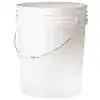I have recently decided that I'd rather have base ingredients that I am store in my pantry in order to make more meals from scratch as opposed to getting things premade. A friend of mine told me there's no way that they would store flour anywhere but the fridge, otherwise it would eventually get bugs in it.
I have looked around and found these two related questions:
Is it okay to keep flour in the freezer?
What is the best way to store the whole wheat flour for daily usage?
However I don't think that either really addresses specifically the concern of bugs, or the preferred storage location of pantry vs. fridge vs. freezer. I don't do much baking, but I wouldn't be opposed to starting (provided that my flour doesn't get bugs in it!) For now though, most of my uses of flour would be in small amounts for stovetop recipes and the occasional breading, so I'm not too concerned about my flour not rising properly (mentioned here), or throwing off the baking time because of a temperature difference (mentioned here). Is the fridge enough to stop the bugs? Or is a freezer necessary? Is the container being airtight the only thing that matters?
EDIT: In response to a comment, I am located in Minnesota, in the United States Midwest region.

